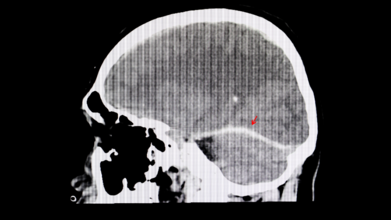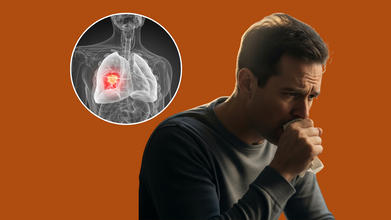- Health Conditions A-Z
- Health & Wellness
- Nutrition
- Fitness
- Health News
- Ayurveda
- Videos
- Medicine A-Z
- Parenting
- Web Stories
Manhattan Shooter Cited CTE in Suicide Note: Here Is What the Condition Means

A recent tragic shooting in Midtown Manhattan has pulled an obscure but alarming brain disease back into the headlines. The shooter reportedly left behind a suicide note claiming he suffered from CTE, short for chronic traumatic encephalopathy, a condition linked to repeated head trauma. As shocking as the incident was, it has opened up a floodgate of questions: What exactly is CTE? Can it really make someone act out violently? And how can we even know if someone had it?
What Exactly Is CTE?
CTE is not your everyday concussion aftermath. It is a progressive, degenerative brain disease caused by repeated head injuries, the kind you get from rough contact sports, military service, or just too many unfortunate falls. Over time, these impacts seem to trigger the buildup of an abnormal protein in the brain called tau. This sticky substance does not just sit there quietly. It gradually spreads through the brain, messing with vital functions and causing serious, irreversible damage.The Symptoms
People with CTE do not wake up one morning knowing something is wrong. The symptoms can creep in slowly, subtle at first, then increasingly hard to ignore, leading to memory lapses, confusion, impulsive behaviour, unexplained aggression, mood swings, deepening depression and, in many tragic cases, suicidal thoughts.It is the sort of change that can feel like a personality transplant. Loved ones often report seeing someone “become a different person” over time.
Not Just a Pro Athlete Problem
For a long time, CTE seemed to be the unwanted souvenir of retired American football players. The sport's culture of full-body collisions made it the perfect storm for head trauma. But recent research is telling a more disturbing story. A 2023 study uncovered CTE in younger, amateur athletes, including teens as young as 17.Back to the Manhattan case. While the shooter’s note mentioned CTE, we still do not know whether he actually had it, let alone whether it influenced his behaviour. This brings up messy territory: should possible brain disease be considered in criminal responsibility? Can CTE be a mitigating factor in violent crime?
It is a grey zone. And until we develop reliable tools to diagnose CTE in the living, we are mostly left guessing.
What Can We Do?
CTE is a slow, silent thief, robbing people of their memory, emotions, and identity. And while scientists are racing to understand it better, prevention remains our best bet for now. That means:- Rethinking how we approach youth and professional sports
- Reducing repeated head trauma wherever possible
- Keeping an eye out for changes in behaviour following head injuries
Your Home May Look Clean, But These 8 Spots Are Dirtier Than You Think

Credits: Canva
You may be cleaning your house well, however, there may still be spots, corners, and places that you could be missing. But, what makes germs stick in these corners longer than other spots? Well, there could be certain reasons, that determine the duration of a germ, including:
Surface Types: solid surfaces like counters or textured surfaces
Living Habits: How often do you clean or disinfect surfaces
Lifestyle Practices: Washing hands and bathing regularly
Cleaning Procedures: What you use to clean, whether it is using bleach or alcohol based cleaning supplies
What Are The Top 8 Dirtiest Spots In Your House?
Kitchen
As per the National Sanitation Foundation (NSF), areas where food is kept, stored or prepared have the most bacteria as well as fecal contamination than any other place in your home.
In fact, more than 75% of dish sponges and rags have Salmonella, E. coli, and fecal matter compared with 9% of bathroom faucet handles.
The elements in kitchen that needs to be cleaned frequently include:
- Cutting boards
- Coffee maker
- Refrigerator, especially where uncooked food is kept
- Kitchen sinks and counter tops
What can you do? Use disinfectant wipes on faucets, refrigerator surfaces and counter tops. You can also damp sponges in microwave for a minute to kill bacteria.
The World Health Organization (WHO) also recommends washing your hands for at least 20 seconds before and after you touch raw meat or unprepared food.
ALSO READ: Dirtiest Things That You Touch In A Restaurant That Could Cause Food Poisoning
Knobs, Door Handles, Switches
These surfaces are touched continuously. While, it may miss out from daily cleaning, however, if you come to think about it, these places may be touched more than you would ever keep a count of.
NSF also found that bathroom light switches, refrigerator handles, stove knobs, and microwave handles were the dirtiest places in the house. You can use disinfecting wipes once a week to ensure they are clean and safe to use.
Your Makeup Corner
The place where you keep your makeup, and even your make up bag is one of the dirtiest places and this can infect your eyes, or cause skin infections.
A 2020 Lancet study shows that viruses can also get on makeup applicator from your hands and could make way to your eyes, nose, and mouth.
The best way to deal with it? Change the way you store your makeup. Make sure all the products are stored clean and dry. Clean your makeup brushes, wash them once a week with regular soap and water, or use an alcohol spray. Some doctors also recommend replacing cosmetics every 6 months.
Bathroom
Of course it is one of the dirtiest places in your home. This is where you scrub off dirt from your body and thus, becomes a breeding ground for bacteria.
There is also a lot of moisture in the bathroom, an environment that helps germ grow.
Where should you pay special attention? Shower tub, drains, faucets, floor around the toilet seat, bath towels, and toothbrushes.
ALSO READ: Your Towels Are Making You Sick— How Often Should You Wash Them?
Make sure you flush the toilet with its lid on.
Laundry
Leaving damp laundry in the washing machine, even if for just 30 minutes, can create the perfect environment for germs to grow. Always move clothes to the dryer right after the wash cycle ends.
If you’ve forgotten a load for a while, it’s best to rewash it. When using a laundromat or shared laundry room, wipe the washer drum with a disinfectant wipe before use.
Also, avoid folding clean clothes on public surfaces without wiping them down first. Washing clothes in warm or hot water, notes UNICEF, especially items worn in public, is more effective at killing viruses and bacteria than cold water.
Home Office & Living Room
NSF found that remote controls, keyboards, phones, and tablets are often shared among family and guests, and they’re germ hotspots. It also found mold, yeast, and even Staphylococcus on remotes and game controllers in multiple households.
A 2018 study published in the International Journal of Environmental Research and Public Health found that carpets can trap up to eight times their weight in dirt, sometimes making them dirtier than a city sidewalk. Viruses can survive for up to 3 days on plastic surfaces like remotes and keyboards.
Wipe down these items regularly with disinfectant wipes or a soapy cloth, and always wash your hands after returning home before touching any surfaces or electronics.
Pets
Your furry friends can bring germs indoors, especially if they spend time outside. Pet bowls, as per NSF, rank as the 4th germiest item in the home, with toys close behind. Studies have found staph, yeast, and mold on pet items.
Some helpful hygiene tips:
- Wash bowls daily with warm, soapy water
- Soak toys and bowls in diluted bleach weekly
- Clean hard toys with hot water regularly
- Wash soft toys once a month
- Wipe your pet’s paws before they come inside.
While your pet may not get sick, the germs they carry can easily transfer to your hands or face.
Personal Items
Every time you return home, you might be unknowingly bringing in bacteria and viruses, on your shoes, phone, wallet, or even headphones.
In a study by NSF of 22 homes, fecal bacteria, yeast, and mold were found on:
- Phones
- Keys
- Wallets and cash
- Lunchboxes
- The bottoms of purses
Since many of these items are made of plastic or metal, some viruses can live on them for up to 72 hours.
Disinfecting wipes work well on most of these surfaces. For electronics, consider using wipes specifically made for tech gear to avoid damage.
Did You Know? You're Wired To Monotask, Not Multitask

Credits: Canva
The world we are living in is constantly forcing us to do more than one thing simultaneously and we have made multitasking the new normal. Thanks to COVID-19 pandemic, we are now used to manage chores while attending a work meeting. But, is this really normal?
On a day to day basis, we process a lot of information, including what is happening at work, the news, social media and of course personal lives. While this is a common phenomenon, it can leave us confused with all the information overloaded and can lead to brain fog, impaired memory, and burnout.
As per a survey by the Movachen Agency, where 2,000 people participated, half of them continued to work even during their vacation. This has further led to the increased blurred lines between work and rest.
What is the alternative?
Monotasking. It means doing one thing at once, as the word 'mono' literally translates to 'one'. While it sounds simple, it could become a struggle for those who are used to multi-tasking, especially since it has left many of us with fractured attention.
Multitask as a term and phenomenon came into existence from 1960s, when computers could perform multiple tasks at once. Ever since, with technology advancements, multitasking became common.
Why are you wired to monotask?
A 2023 study, titled, Biological stress responses to multitasking and work interruptions: A randomized controlled trial, was the first comprehensive investigation into humans' biological stress as a response to multitasking and work interruptions.
The findings show that we can adapt to stress of doing multiple things but only to a point. Eventually, it does lead to a lot of harm, and stress thus becomes chronic.
So, how can monotask help you?
Monotask can alleviate some of that stress on your brain, and it is a muscle that you could also rebuild. It can also help to:
- Reduce stress
- Reduce to-do list
- Improve personal relationship
- Improve quality of work
How can you monotask?
We’re all born with a natural talent for monotasking. If you just watch a child completely absorbed in stacking blocks or drawing, it is a perfect example of monotasking. They’re fully present, focused on one thing at a time.
As adults, though, we tend to lose that skill in the rush of multitasking. But the good news? You can rebuild your monotasking “muscle.” Start small, with simple everyday tasks, and you’ll find it easier to focus on bigger, more demanding ones later.
In his book The Twelve Monotasks, Thatcher Wine explains that focus is something we can train, through daily activities like walking, reading, eating, listening, even sleeping. These are opportunities to practice giving your full attention to just one thing.
Yes, this probably means putting your phone down. But it’s worth it. Try using a timer, short blocks of focused time followed by breaks, to help you ease in.
Here are a few easy ways to practice monotasking:
- Take a 10–20 minute walk: Leave your headphones, camera, and even your dog behind. No podcast, no playlist. Just walk. Feel your body move, breathe deeply, and tune in to the sounds around you. It might feel weird or boring at first, that’s part of the process.
- Eat without distractions: Step away from screens and take a real break for your meal. Savor each bite. Notice the textures, flavors, and how the food makes you feel. Eat mindfully.
- Look at one thing, deeply: Watch a sunset or the clouds drifting by. Study a tree, a flower, or a painting. The goal is to really see it, notice the colors, the movement, the details you’d usually miss.
Even activities like coloring, doing puzzles, washing dishes, or folding laundry can become great monotasking exercises when you give them your full attention.
Start where you are, go slow, and remember: doing one thing at a time isn’t a step back, it’s a step toward being more present and less scattered.
World Lung Cancer Day 2025: Why You Should NOT Ignore A Recurring Cough? Danger Of Overlooking Early Symptoms

Credits: Health and me
Lung cancer remains one of the deadliest forms of cancer worldwide, accounting for nearly one in five cancer-related deaths each year. What makes this cancer especially dangerous is how silently it advances. Many people miss the early signs or ignore them, believing they’re just symptoms of a lingering cold, allergies, or an old infection but on World Lung Cancer Day—observed every year on August 1—the message is clear, early detection can mean the difference between life and death.
First observed in 2012, World Lung Cancer Day was launched by the Forum of International Respiratory Societies (FIRS) in partnership with patient advocacy groups. The aim? To break the silence surrounding lung cancer, correct widespread misconceptions, and push for better early detection and prevention.
Despite advances in medicine, lung cancer continues to slip under the radar. Many associate it solely with smoking, overlooking other contributors like air pollution, genetic factors, or secondhand smoke. Moreover, stigma often deters patients from seeking help early especially non-smokers who don’t consider themselves at risk.
While a chronic cough might seem harmless, dismissing it as seasonal or due to pollution, the reality is that it could be your body’s early warning system. Lung cancer rarely causes symptoms in its earliest stages, which is why seemingly minor signs like a persistent cough or subtle breathlessness deserve closer attention. By the time more severe symptoms—like coughing up blood, wheezing, or unexplained weight loss—appear, the disease may already be in an advanced stage.
What makes lung cancer particularly dangerous is its ability to remain silent until it’s too late. This is why awareness and early screening, especially in high-risk groups, are crucial. Smokers and former smokers, people exposed to secondhand smoke or environmental toxins, and those with a family history should be especially vigilant. Even if you don’t fall into these categories, don’t ignore your instincts. If something feels off—get it checked.
When a Cough Isn't 'Just a Cough'
Dr. Rakesh Pandit, Senior Consultant & Head of Internal Medicine at Aakash Healthcare, emphasizes that we often brush off coughs that last beyond a week or two, that’s a mistake. “A recurring cough is not always just a leftover from the flu or a seasonal allergy,” he says. “It could point to asthma, acid reflux, lung infections, tuberculosis—or even early-stage lung cancer.”
Dr. Pandit adds that if a cough persists for over eight weeks in adults (or four weeks in children), it needs medical attention. And it’s not just about coughs—symptoms like breathlessness, chest pain, coughing up blood, wheezing, or unexplained weight loss should be immediate red flags.
In fact, lung cancer is often detected late because the symptoms can be vague or mimic other conditions, a long-standing cough, shortness of breath, and fatigue—these aren’t always alarming on their own, but together, they can signal something serious.
Technological advances in low-dose CT scans now allow for earlier detection, improving survival rates significantly. The five-year survival rate for early-stage lung cancer can be as high as 60%, compared to just 6% in advanced stages. That’s a major difference—and it all starts with paying attention to symptoms that seem small.
Also, it’s not just about cancer. Chronic coughing and breathlessness can be early signs of other serious conditions like COPD, pulmonary fibrosis, or even heart failure. So addressing them isn’t just about cancer prevention—it’s about taking charge of your overall respiratory health.
What Missed Symptoms Can Lead To?
Dr. Sachin Kumar, Director of Pulmonology & Critical Care Medicine at Sakra World Hospital in Bengaluru, recalls a case that perfectly illustrates the cost of late detection. A 48-year-old man visited a doctor for back pain. Painkillers didn’t work. An MRI revealed cancer in the spine—further tests showed the primary cancer was in the lungs. It had already spread.
“This is how deceptive lung cancer can be,” Dr. Kumar explains. “Often, the first symptoms don’t even involve the lungs. That’s why awareness is key.”
Why Lung Cancer Is Not Just a Smoker’s Disease?
One of the most dangerous myths about lung cancer is that only smokers are at risk. While smoking remains the number one cause, non-smokers aren’t safe either. Dr. Debanti Banerjee, Consultant at HCG Cancer Center, Kolkata, warns that more young adults, women, and non-smokers are being diagnosed than ever before.
“Increasingly, we’re seeing lung cancer in non-smokers—possibly due to genetic predispositions, air pollution, and environmental toxins,” she explains. “People must understand that anyone can get lung cancer, and everyone needs to be vigilant about symptoms.”
She adds, “Lung cancer doesn’t always shout—it often whispers. Catching it in stage 1 or 2 can mean curative treatment. Catching it at stage 3 or 4? That’s a different story.”
What Are The Environmental Triggers and Everyday Risks?
In addition to smoking and secondhand smoke, prolonged exposure to pollution, dust, biomass fuel (like wood or coal used for cooking), and occupational hazards (like asbestos) significantly increase lung cancer risk. People living or working in such conditions often develop chronic coughs from continuous lung irritation. Unfortunately, this persistent irritation can mask the early signs of something more dangerous.
“Especially in urban environments, we’re breathing in harmful particles every day,” Dr. Pandit says. “If you’re in a high-risk environment, you can’t afford to ignore a chronic cough or delay a check-up.”
What You Can Do To Prevent And Early Diagnosis?
Here’s the thing—lung cancer caught early is often treatable but because early symptoms are vague, diagnosis is frequently delayed. The solution lies in being proactive.
- Don’t dismiss persistent symptoms, especially coughs, breathlessness, fatigue, or weight loss.
- Get screened if you’re high-risk, this includes smokers, ex-smokers, people over 50, or those with a family history.
- Avoid triggers, stay away from secondhand smoke, reduce exposure to pollution, and use protective gear if working in hazardous conditions.
- Vaccinate for infections like tuberculosis and influenza can damage lungs and increase vulnerability.
- Annual health checks should be part of your routine, not just something you do when you’re sick.
“Most causes of a recurring cough are treatable if caught early,” Dr. Pandit says. “That’s why a cough that won’t quit needs more than just home remedies or over-the-counter syrup. It needs medical evaluation.”
When detected in its early stages, non-small cell lung cancer (NSCLC)—the more common and slower-growing form—can often be removed surgically or treated with radiation and targeted therapies. But in later stages, treatment gets more complicated and outcomes become uncertain.
Dr. Banerjee sums it up best, “We need to move beyond fear and stigma. Early diagnosis isn’t about being alarmist—it’s about giving people a fighting chance.”
The theme of World Lung Cancer Day isn’t just about awareness. It’s a call to action- to listen to your body, to challenge the assumptions around who gets lung cancer and to make preventive health a priority. So, if you or someone you know has a cough that keeps coming back, don’t wait.
© 2024 Bennett, Coleman & Company Limited

